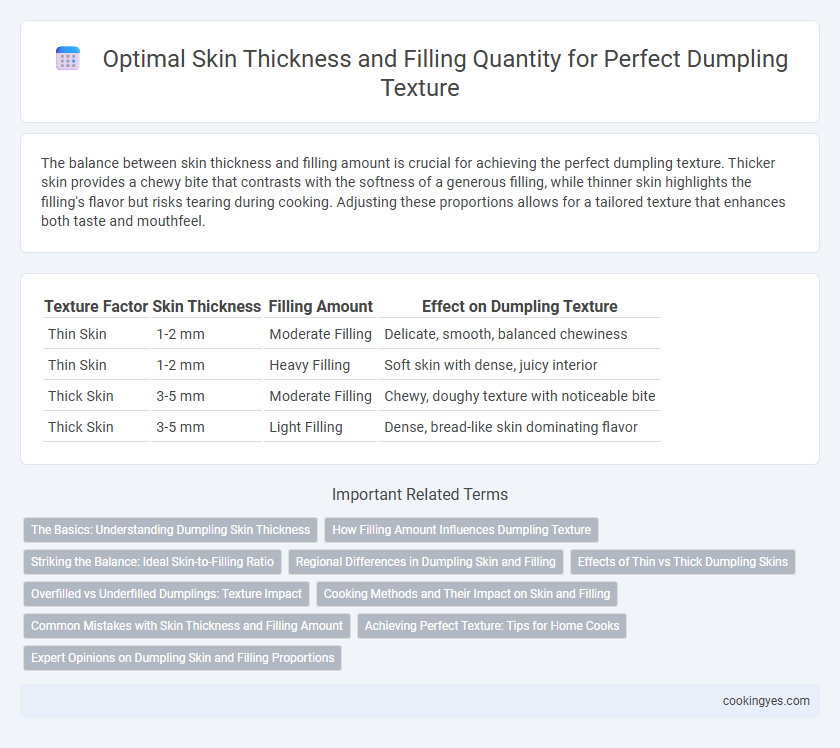The balance between skin thickness and filling amount is crucial for achieving the perfect dumpling texture. Thicker skin provides a chewy bite that contrasts with the softness of a generous filling, while thinner skin highlights the filling's flavor but risks tearing during cooking. Adjusting these proportions allows for a tailored texture that enhances both taste and mouthfeel.
Table of Comparison
| Texture Factor | Skin Thickness | Filling Amount | Effect on Dumpling Texture |
|---|---|---|---|
| Thin Skin | 1-2 mm | Moderate Filling | Delicate, smooth, balanced chewiness |
| Thin Skin | 1-2 mm | Heavy Filling | Soft skin with dense, juicy interior |
| Thick Skin | 3-5 mm | Moderate Filling | Chewy, doughy texture with noticeable bite |
| Thick Skin | 3-5 mm | Light Filling | Dense, bread-like skin dominating flavor |
The Basics: Understanding Dumpling Skin Thickness
Dumpling skin thickness plays a crucial role in achieving the ideal texture by balancing softness and chewiness against the filling amount. Thinner skins create a delicate wrapper that highlights the filling's flavor, while thicker skins provide a heartier bite but require careful filling proportion to avoid a doughy taste. Optimal dumpling texture depends on matching skin thickness with the appropriate filling quantity, ensuring the dumpling holds together without overpowering the palate.
How Filling Amount Influences Dumpling Texture
The filling amount directly affects the dumpling's texture by determining the balance between chewiness and softness in each bite. Thicker skins paired with larger fillings create a hearty, dense texture, while thinner skins with moderate filling ensure a delicate, tender mouthfeel. Optimal filling proportions maintain structural integrity without overpowering the skin, resulting in a harmonious texture that highlights both components.
Striking the Balance: Ideal Skin-to-Filling Ratio
Achieving the ideal skin-to-filling ratio is crucial for dumpling texture, with a skin thickness of approximately 1 to 2 millimeters providing the optimal balance between durability and tenderness. Overly thick skins can overwhelm the filling and result in a chewy bite, while excessively thin skins may tear easily during cooking and fail to contain the filling effectively. Maintaining a filling amount that complements this skin thickness ensures dumplings that hold their shape, offer a satisfying mouthfeel, and highlight the filling's flavors without compromise.
Regional Differences in Dumpling Skin and Filling
Dumpling skin thickness and filling amount vary significantly across regions, directly affecting texture and flavor balance. In Northern China, dumplings feature thicker skins to hold larger volumes of hearty fillings, providing a chewy texture that complements robust meat mixtures. In contrast, Southern Chinese dumplings often have thinner, more delicate skins paired with smaller, finely minced fillings, creating a tender bite and emphasizing subtle flavors.
Effects of Thin vs Thick Dumpling Skins
Thin dumpling skins create a delicate, tender texture that allows the filling's flavors to stand out, while thick skins offer a chewier bite and better structural support for larger filling amounts. Thinner skins may tear easily with dense fillings, reducing overall dumpling integrity, whereas thicker skins accommodate more filling without compromising shape or cooking quality. Balancing skin thickness and filling quantity is crucial for achieving the ideal texture and mouthfeel in dumpling recipes.
Overfilled vs Underfilled Dumplings: Texture Impact
Dumpling skin thickness and filling amount significantly influence texture, with overfilled dumplings often resulting in tearing and soggy wrappers, while underfilled ones yield a chewy, doughy bite. Optimal skin thickness ensures the wrapper can stretch without breaking, maintaining a balanced texture and preventing leakage during cooking. Proper filling distribution enhances juiciness and structural integrity, creating a desirable contrast between tender skin and flavorful interior.
Cooking Methods and Their Impact on Skin and Filling
Cooking methods directly influence dumpling skin thickness and filling amount, affecting texture and overall eating experience. Steaming preserves a supple, tender skin that balances thinner dough with generous, moist filling, enhancing juiciness without bursting. Pan-frying demands slightly thicker skin to withstand crisping and heat, accommodating moderate filling to maintain structural integrity and prevent leakage.
Common Mistakes with Skin Thickness and Filling Amount
Common mistakes in dumpling preparation include using excessively thick skin, which creates a doughy texture overshadowing the filling, and overloading with too much filling, causing the dumpling to burst during cooking. Optimal skin thickness ranges from 1 to 2 millimeters, providing a delicate balance that supports the filling without overpowering it. Filling quantities should be moderate, typically around 1 to 1.5 teaspoons for standard-sized dumplings, ensuring proper sealing and a harmonious bite.
Achieving Perfect Texture: Tips for Home Cooks
Achieving the perfect dumpling texture depends on balancing skin thickness and filling amount; thinner skins require less filling to avoid tearing while thicker skins can hold more without compromising chewiness. Ideal skin thickness ranges from 0.5 to 1 mm, providing elasticity and a tender bite that complements the savory filling. Adjust filling volume to about 15-20 grams per dumpling to ensure a satisfying, uniform texture that cooks evenly and retains juiciness.
Expert Opinions on Dumpling Skin and Filling Proportions
Expert chefs emphasize that the ideal dumpling texture depends heavily on balancing skin thickness with the amount of filling, recommending a thin skin to allow the filling's flavor to shine without becoming overly dense. Culinary specialists note that thicker skins provide a chewier bite but can overpower delicate fillings, so a moderate filling amount ensures the dumpling retains structural integrity without bursting during cooking. Research in food science highlights that optimal moisture content in the filling combined with precise skin thickness enhances the overall mouthfeel and eating experience.
Skin Thickness vs Filling Amount for Dumpling Texture Infographic

 cookingyes.com
cookingyes.com